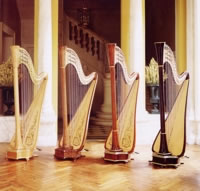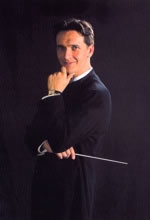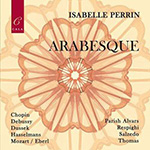Arabesque.
A journey into Harp Artistry by Isabelle
Perrin
|
| Artist Profile and index of recordings and sheet music |
| 1 | LA SOURCE | Alphonse Hasselmans (1845-1912) | 4:02 |
| 2 | ARIA AND RONDO PASTORAL (ARR. J THOMAS) | Wolfgang Amadeus Mozart (1756-1791) | 9:10 |
| 3 | PRELUDE Op. 28 No. 1 | Frédéric Chopin (1810-1849) | 6:16 |
| 4 | FLOWING STREAM | Chinese traditional | 4:46 |
| 5 | SONATA
IN C MINOR (ALLEGRO-ANDANTINO-RONDO ALLEGRO) |
Johann Ladislav Dussek (1760-1812) | 7:25 |
| 6 | CHANSON DANS LA NUIT | Carlos Salzedo (1885-1961) | 3:33 |
| 7 | MINSTREL’S ADIEU TO HIS NATIVE LAND | John Thomas (1826-1913) | 8:35 |
| 8 | SERENADE | Elias Parish Alvars (1808-1849) | 7:25 |
| 9 | SICILIANA | Ottorino Respighi (1879-1936) | 4:48 |
| 10 | ARABESQUE | Claude Debussy (1862-1918) | 5:53 |
| 11 | DANSES SACRÉE ET PROFANE | Claude Debussy (1862-1918) | 9:56 |
Total
Time |
1:11:59 |
||
This CD was recorded in May 2002 and originally released as an SACD by First Impression Music on M045. Cala has picked it up, dressed it down and reissued it in its accustomed livery. Internationally admired Isabelle Perrin joined the San Francisco Symphony Orchestra and later on the Orchestre National de France as co-principal harpist, a position she held for 25 years. She has also made numerous recordings and done much to further knowledge of the harp. She has numerous publications to her name and is a visiting professor at prestigious institutions.
Sleeve Notes
The Harp Through
The Ages
Derived from the primitive musical bow, the harp appeared as early as
3000 b.c. The Egyptian harp (2500 b.c.) was quite large and featured
six to eight strings, a number which was to double later on. None of
those instruments featured a supporting column and thus, were not capable
of withstanding great tension; their sound was therefore soft and mellow.
In the 9th Century b.c., the supporting column made its first appearance on an instrument from Syria. Late; the Greeks began imitating the Syrian design as revealed on many painted vases from the 6th Century b.c. It is most likely the Greeks who introduced the harp in Europe where, as early as the Middle Ages, it was played in Wales and Ireland by bards and Celtic poets. The portative harp became, in the 12th Century, an essential instrument for the jugglers, troubadours, minstrels and Minnesänger who made it hugely popular. It already resembled the modern harp, smaller in dimensions with the same elegant curvature.
It is in the 15th Century that music expressly composed for the harp appears mostly in Spain and Italy. Having reached a popular status, the harp design evolved dramatically and featured a double row of strings tuned as the black and white keys of the keyboard which gave it a new name: “arpa doppia.” In the 16th Century the Welsh harp appeared, featuring three rows of strings (the two outside rows tuned as the white keys and the central row as the black keys.) This particular period was not, however, prolific for the harp, which suffered a sharp decline in interest until the end of the 17th Century when the pedal system was invented. Using rods through the supporting column, these pedals triggered small hooks, which could shorten each string. This device allowed each string to play two notes, thus replacing the need for the cumbersome second row of strings. It is for this instrument that Mozart wrote in 1778, his celebrated Concerto for Flute and Harp.
At the end of the 18th Century the hooks were
replaced by “forks"
(two prongs mounted on a disc) and at the beginning of the 19th Century;
a “double action”
system for each pedal was developed (seven pedals total, one for each
note of the scale.) This technological break-through allowed the harp
to play three notes per string, thus covering the entire chromatic scale.
The harp reached its apex at the end of the 19th Century and the beginning
of the 20th Century. Debussy and Ravel were particularly fond of its
pastel tones. The mid and late 20th Century provided a substantial contribution
to the harp repertoire in the hands of many composers who were drawn
to its formidable array of sonorities.
 CHOOSING
THE CAMAC HARP
CHOOSING
THE CAMAC HARP
I have been connected to the harp manufacturer Camac for many years.
Upon completing my studies at the Juilliard School in New York, I returned
to France where I obtained a teaching position in Nantes, on the West
Coast. It is there that I met Joel Gamier, founder and Director of the
Camac Company. The following years saw the nurturing of a great friendship
and collaboration. Joel Gamier, unfortunately now deceased, loved the
harp passionately and dedicated his life to the honing of his manufacturing
process. He had distinct ideas, which revolutionized the technical conception
of the instrument and was constantly seeking the advice of professional
harpists in his quest to further refine his instruments’ sonority.
His initial focus was student harps, which he refined to such high degree
that they quickly spread into the professional realm. Jakez François,
his successor, continues that tradition of discovery and innovation,
which will further refine this great instrument.
I have played on a Camac Atlantide Prestige Harp
for many years now, and I must say that it has never disappointed me.
The distinctive clarity of its sound and its marvelous projection are
completely in accord with the qualities I expect from my instrument.
“Arabesque” IN THE MAKING
The idea behind this recording project
was inspired by the encounter of Christophe Chagnard, conductor, with
whom I had the opportunity to work at the Sixth World Harp Congress
in the USA, Winston Ma, producer, and myself. Our deep common musical
understanding and the notorious difficulty of recording such a tonally
complex instrument as the harp, set the stage to take on what we perceived
as a great challenge.
THE REPERTOIRE
My choice of repertory was meant to be as eclectic as possible, as much
in the various styles and time periods as in the distinct character
of the different compositions, thus reflecting what could be featured
at one of my recitals. Some famous pieces (often conceived initially
for the piano and beautifully adapted for the harp) as well as lesser-known
selections were assembled to provide the widest possible perspective
on this magical instrument, and for each number to further enhance
our love of it. It is my hope that my choices and preferences will
provide the listeners with a glimpse of the immense pleasure I had
in recording this album.
Isabelle Perrin. (Translated from French
by Christophe Chagnard)
All rights reserved.
HASSELMANS: LA SOURCE
In this strikingly evocative piece, Hasselmans makes use of the contrast
between the treble and bass of the harp to create, by means of arpeggios
as accompaniment, the sound of water flowing while the melody suggests
droplets.
EBERL-MOZART: ARIA AND RONDO PASTORAL
This piece features two movements: the first, an “aria con variazioni” was
composed by Eberl, a pupil of Mozart and the second a “Rondo Pastoral” was
originally conceived for string trio by Mozart and later transcribed
for the harp by John Thomas, a 19th Century Welsh harpist who also conceived
of bringing the two compositions together as one opus.
CHOPIN: PRELUDE Op. 28, No. 15
This prelude, charged with intense emotion, was composed during a sojourn
of Chopin and his lover George Sand at Majorca. Finding himself alone
during a stormy afternoon and feeling rather somber, Chopin sat at
the piano and composed a piece which, by the insistent repetitions
of certain notes, suggests drops of rain falling, interrupted by dramatic
chord progressions, revealing the emotional turmoil the composer was
in the midst of during that period.
CHINESE TRADITIONAL: FLOWING STREAM
This popular Chinese folk melody inspired by the sound of water flowing,
lends itself perfectly to the harp’s ability to translate the
fluidity of water through the use of long arpeggios.
DUSSEK: SONATA IN C MINOR
Dussek did nor have to search very far for inspiration to write for the
harp; both his mother and wife were harpists! This sonata was written
in three movements and was conceived as one of three such sonatas presented
as a whole. It proved very successful and became one of the most performed
compositions in the harp repertoire. The first and third movements
are light in character (the third being in the form of a Rondo reminiscent
of a music box) while the second, in a minor mode, is more melancholic.
SALZEDO: CHANSON DANS LA NUIT
Composed in 1934, this piece reveals through great poetry and an impressive
science of tone colours, a rich variety of sounds including the use
of nails, tapping of the soundboard and many different types of glissandi.
THOMAS: MINSTREL’S ADIEU TO HIS
NATIVE LAND
This moving piece was inspired by a poem from Moore of the same title.
It begins with a grave and solemn theme followed by variations which
lead us to believe in a happy unfolding (the fourth variation), but ending
with a coda reminiscent of the opening theme’s mournful character.
PARISH ALVARS: SERENADE
Hector Berlioz, a great admirer of Parish Alvars, described him as “the
Liszt of the harp.” This Serenade is indeed a true virtuoso piece
of great difficulty. The introduction is particularly challenging with
the use of harmonics throughout the “love song” motive, later
restated in the coda as well.
RESPIGHI: SICILIANA
It is in 16th Century lute music that Respighi found the inspiration
for his Siciliana, which he originally composed for string orchestra.
It was later arranged for the harp by Marcel Grandjany who made use
of all the harp’s resources to create a piece of great melodic
beauty and virtuosity.
DEBUSSY: ARABESQUE
The term arabesque indicates a complex and ornate design of intertwined
floral and geometrical figures. Although initially conceived for the
piano, this piece seems to have been meant for the harp. The fluidity
of irs arpeggios for instance feels so natural on the harp that this
Arabesque is performed more often by harpists than pianists!
DEBUSSY: DANSES SACRÉE ET PROFANE
Debussy clearly had a predilection
for the harp, an instrument he incorporated in nearly all of
his orchestral works. The Dances sacrée et profane
were conceived in 1903 as examination pieces for the Brussels
Conservatory. The two dances are played without interruption
while displaying very distinct contrasts. The Spanish influence
is particularly strong in the “Danse profane” while
the “Danse sacrée” was inspired by a short
piece by Portuguese composer Francisco de Lacerda.
Isabelle Perrin. (Translated from French
by Christophe Chagnard)
All rights reserved.
 CHRISTOPHE
CHAGNARD
CHRISTOPHE
CHAGNARD
One of the most sought-after conductors in the Pacific Northwest, French
conductor Christophe Chagnard is an all-around musician acclaimed for
his finely-etched performances and charismatic approach to music. As
co-founder of the Northwest Sinfonietta, in a few short years Mr. Chagnard
has built the finest chamber orchestra in the Northwest and performs
regularly with some of the biggest names in music — among them
Nadja Salerno-Sonnenberg, Lynn Harrell, Richard Stoltzman, Lara St. John
and Awadagin Pratt.
A gifted communicator, Mr. Chagnard draws audiences into a piece of music with a direct approach that is compelling and distinctly his own, He has been praised by The News Tribune as an “intensely musical conductor given sometimes to attempting unconventional performances.” With a repertoire that cuts across the chamber, symphonic and choral repertories, Mr. Chagnard brings the finely-honed sensibilities of the chamber musician to orchestral performance. A commitment to music of our time, a keen interest in mentoring and encouraging young musicians, and an easy manner in front of audiences help make him the complete musician.
 THE
NORTHWEST SINFONIETTA was created in 1991 by Christophe Chagnard
and Kathryn Habedank on the occasion of the Mozart Bicentennial. It
features thirty-six of the Northwest’s finest instrumentalists
and performs a wide range of repertoire from Baroque to contemporary
composers. The Northwest Sinfonietta has received numerous accolades
from audience and critics alike and has been held as one of the finest
orchestras of its kind.
THE
NORTHWEST SINFONIETTA was created in 1991 by Christophe Chagnard
and Kathryn Habedank on the occasion of the Mozart Bicentennial. It
features thirty-six of the Northwest’s finest instrumentalists
and performs a wide range of repertoire from Baroque to contemporary
composers. The Northwest Sinfonietta has received numerous accolades
from audience and critics alike and has been held as one of the finest
orchestras of its kind.
“The 12-year-old Northwest Sinfonietta, based in Tacoma under the direction of conductor Christophe Chagnard, has developed into an ensemble that can hold its own among the best classical-music organizations in the Northwest.” The Seattle Times.
For more information on the Northwest Sinfonietta, please visit: www.nwsinfonietta.com
Credits
Executive Producer: Winston MA
Producer: Christophe Chagnard
Recording Engineer: Jeff Mee
Artistic Advisor: Patricia Wooster
Video Engineers: Messrs. Lee Po Chung and Wan Chi Man,
Allied Entertainment Ltd., Hong Kong
Venue: Rialto Theater, Tacoma, Washington USA 14-16 May 2002
Mastering Engineer: Paul Stubblebine, San Francisco USA. October 2003
Recording and Mastering System: Sony DSD recording and mastering system
Photos credit: I. Perrin by Anne Roman, C. Chagnard by Creative Indulgence,
Northwest Sinfonietta by Kate A. Miner.
The Executive Producer and Producer wish to thank Messrs. David Kawakami
and Gus Skinas, Sony SACD Project; The Broadway Center For The Performing
Arts; James Wong of Allied Entertainment Ltd., Hong Kong; and the Camac
Company, France.
Special thanks are given to Mr. Paul Stubblebine for his untiring energy
and unique talent in mastering the recorded material.
© & (P) First Impression Music, Inc.,
USA
Tel.: (425) 868 5326 Fax: (425) 836 9061
wma@fimpression.com
www.fimpression.com
| Instruments: | Harp / Track 11 Harp & Orchestra |
| Genre: | Classical |
| Format: | CD |
| Our Ref: | A0168 |
| MCPS: | -- |
| Label: | Cala |
| Year: | 2015 |
| Origin: | USA |
